As temperatures rise, the weather is getting more extreme. Around the globe, extreme weather events are striking with ever greater frequency and intensity.
In 2020, in the U.S. alone, a record number of 22 climate and weather disasters took place that each caused damage of more than 1 billion dollar, while jointly causing the deaths of 262 people.
Rising temperatures cause stronger storms, droughts, heatwaves and forest fires. Rising temperatures are also behind the cold weather that is currently hitting large parts of North America. Two mechanisms that, by distorting the Jet Stream, are contributing to more extreme weather are described below.
Distortion of the Jet Streams - two mechanisms
The Jet Streams used to circumnavigate the globe in narrow bands. World climate zones used to be kept well apart by stable Jet Streams.
On the Northern Hemisphere, the coldest point used to be the North Pole, so wind used to flow from the tropics to the North Pole, while the wind was moved to the side due to Earth's turning.
 |
| Polar Jet Stream and Subtropical Jet Stream - NOAA image |
This resulted in two Jet Streams forming, circum-navigating the globe in relatively narrow and straight bands, i.e. the Polar Jet Stream at 60°N and the Subtropical Jet Stream at about 30°N.
 |
Polar Jet Stream (blue) and Subtropical
Jet Stream (red) - NOAA image |
The first mechanism distorting the Jet Stream is that, as the Arctic gets hit much harder by temperature rises, the difference in temperature decreases between the North Pole and the Equator.
This slows down the speed at which wind travels from the Tropics to the North Pole, in turn making the Jet Stream more wavy, just like a slow-moving river over flat land will take a winding route and meander.
For years,
Jennifer Francis et al. warned that this will cause more extreme weather in mid latitudes. Arctic-News described
Deformation of the Jet Stream as
Opening the Doorways to Doom, i.e. one of the feedbacks (
#10) of accelerated Arctic warming.
Second mechanism distorting the Jet Stream
Due to the rapid temperature rise of the Arctic Ocean, the North Pole is increasingly not the coldest place on the Northern Hemisphere.
Instead, the air over Greenland, North Canada and Siberia is increasingly more cold than before, and can be much colder than the North Pole, as illustrated by the ClimateReanalyzer image on the right.
This creates temperature and pressure conditions over the East Pacific and over North America that make the Jet Stream branch out.
On the next image on the right, the Jet Stream can be seen running over the West Pacific at speeds as high as 387 km/h or 241 mph (green circle) and moving within a narrow and straight band.
The Jet Stream is then confronted with much different conditions over North America that make the Jet Stream branch out widely (white arrows), with one branch moving north and going circular over the Arctic Ocean, while at the other end a branch can be seen dipping below the Equator.
As a result of these two distortion mechanisms, cold air that used to stay contained over the North Pole, can descend more easily over Siberia and North America, causing more extreme weather, while also taking away opportunities for the sea ice to build up to the strength and depth than it used to have.
The combination image below shows forecasts for February 6, 2021.
On the above combination image, the left panel shows that, not far apart from each other and at the same time, temperature anomalies over North America are forecast to approach the top end and the bottom end of the scale. The right panel shows that temperatures over North America and Siberia are forecast to be much lower than over the Arctic Ocean.
As the temperature difference between land and ocean gets stronger on the Northern Hemisphere in Winter, the transfer of water vapor and heat to the atmosphere increases (#25 on the
feedbacks page, image right). Storms and clouds forming over the North Atlantic trap heat and move much heat toward the North Pole.
Formation of clouds can be further facilitated by aerosols (
feedback #9). A
recent study looks at how melting sea ice can cause more release of iodine into the atmosphere, seeding the growth of new clouds that trap longwave radiation that would otherwise go into space.
The combination image below shows in the left panel how a branch of the Jet Stream is forecast to be moving over the North Pole at speeds as high as 107 km/h or 67 mph on February 16, 2021. Hours later that day, as the globe in the right panel shows, the surface temperature on the North Pole is forecast to be -18°C, i.e. warmer than the white-blue color (about -20°C) that covers most of North America.

As the globe in the left panel of the combination image below shows, temperature anomalies in Texas were approaching the bottom end of the scale on February 15, 2021, i.e. -32°C or -57.6°F (below 1979-2000), while the globe in the right panel shows that on February 16, 2021, temperature anomalies in between Greenland and the North Pole were forecast to approach the top end of the scale, i.e. 32°C or 57.6°F (above 1979-2000).
 Above freezing at North Pole?
Above freezing at North Pole?As the combination image below shows, the temperature at the North Pole is forecast to be 0°C or 32°F, panel right, on February 22, 2021, 18:00 UTC, while temperature anomalies at the North Pole are forecast to be at the top end of the scale, i.e. 32°C or 57.6°F above 1979-2000.
The light-blue color over the North Atlantic on the globe on the left is a cold anomaly resulting from cold air moving from North America over the Atlantic Ocean (forecast initiated Feb.15, 2021, 18:00 UTC).
Ominously, sea ice is breaking up north of Greenland.
And ominously, the N20 satellite recorded methane levels as high as 2835 ppb at 399.1 mb on the afternoon of February 17, 2021.
























































